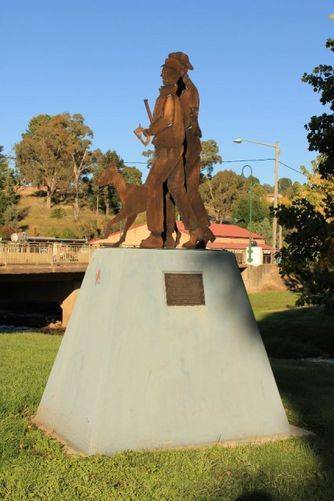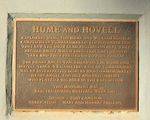
Home » Themes » People » Exploration
Hamilton Hume & William Hovell Print Page 
The monument commemorates the exploration of Hamilton Hume and WIlliam Hovell who camped here in 1824 on their exploration journey to Port Phillip in Victoria. The monument was erected during Heritage Week in 2001.
In 1824, Hamilton Hume and William Hovell led an expedition of discovery to find new grazing land for the colony. They and their party trekked south from Appin to Lake George, then on into Victoria, keeping west of the Great Dividing Range and ending up at Corio Bay, on the Victorian coast, where present day Geelong is situated. (Hovell mistakenly believed they had arrived at Westernport, and did not realise his mistake until after his return.)
On 8 November 1824 from Big Hill, near Tumbarumba, they became the first Europeans to sight the Australian Alps. In his excitement Hovell wrote in his journal..."a prospect came into view the most magnificent, this was an immence high Mountain Covered nearly one fourth of the way down with snow, and the Sun shining upon it gave it a most brilliant appearance."
Location
| Address: | Hammond Lane, Tumbarumba, 2653 |
|---|---|
| State: | NSW |
| Area: | AUS |
| GPS Coordinates: | Lat: -35.776345 Long: 148.009125 Note: GPS Coordinates are approximate. |
Details
| Monument Type: | Monument |
|---|---|
| Monument Theme: | People |
| Sub-Theme: | Exploration |
| Designer: | Judy Cameron |
| Monument Manufacturer: | Mary & Murray Phillips |
| Link: | https://www.sl.nsw.gov.au/stories/h… |
Dedication
| Approx. Monument Dedication Date: | 2001 |
|---|
Hume and Hovell
Explorers Hamilton Hume and William Hovell camped near Tumbarumba on 8th November 1824.
They saw the snow clad Australian Alps, they argued about which direction they should take and then pressed on to Port Phillip.
The Henry Angel Trackhead on the Hume and Hovell Track, 8 kilometres east of Tumbarumba, has an interpretive display and commemorates Henry Angel, convict and pastoralist who played a big role in the expedition.
This monument was erected during Heritage Week 2001.
Design - Judy Cameron
Fabrication - Mary and Murray Phillips






